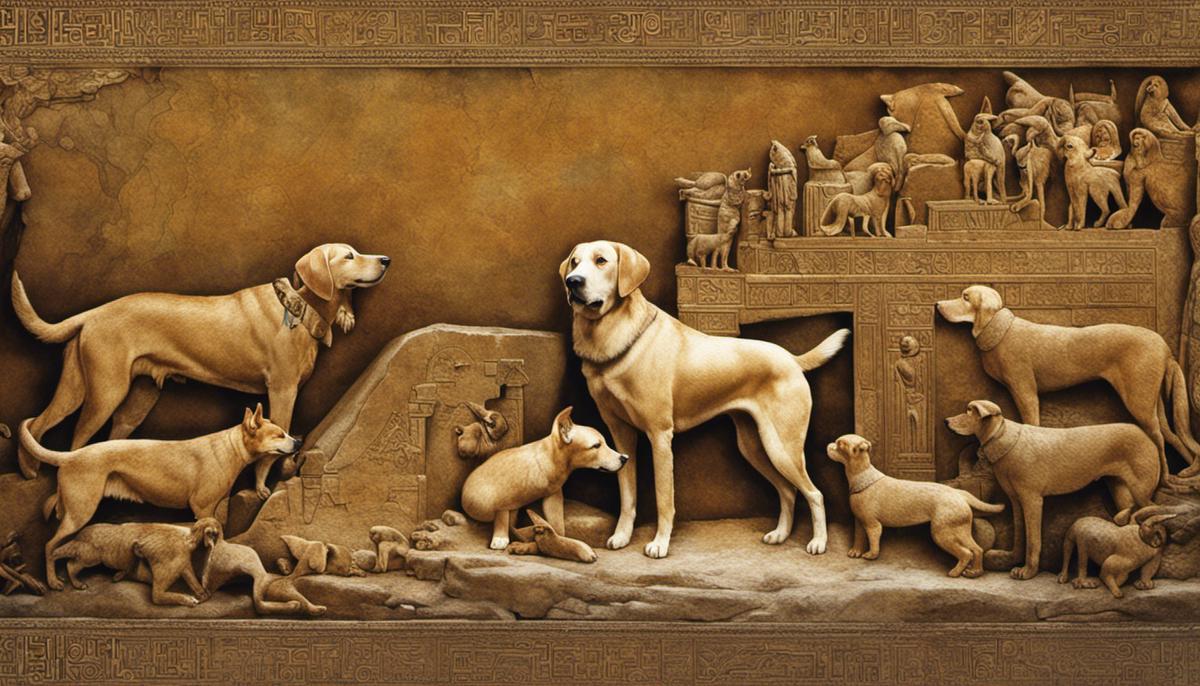In ancient texts and religious scriptures such as the Bible, every creature, including dogs, holds significant representations and meanings. Drawing from biblical references, this discourse aims to dissect meanings associated with dogs and how they translate to modern interpretive dreams involving dog attacks. Although the Bible frequently relates dogs with elements of uncleanliness or contempt, we thread deeper into the texts to discern underlying symbolic implications. Furthermore, we delve into the immense contributions of psychological giants, including Sigmund Freud and Carl Jung, to connect their theories of dream interpretations with related imagery. Amid integrating biblical and psychological interpretations, we aim to illuminate a comprehensive understanding of what these dreams signify from a biblical perspective.
Alongside this, individual experiences depicted through a series of case studies broaden our comprehension of these dreams’ impact on faith and everyday life—providing a different, more personal lens through which the experiences could be evaluated. Thus, the endeavor here is to form a multidimensional view, digging deeper than the surface meanings and integrating various perspectives into a cohesive narrative.
Symbolic Significance of Dogs in the Bible
The exploration of dogs’ depiction in biblical contexts provides an intriguing canvas to study, unveiling the traditions, values, and beliefs surrounding ancient civilizations. This article delves into the possible implications of the occurrence of canines within these revered pages, oftentimes revealing surprising complexities and multitudes of interpretations that can broaden our understanding of human-animal relationships in historical and religious contexts.
Strikingly, one of the most prominent aspects of canines in the biblical narrative heralds from their seldom positive portrayal. More often than not, dogs are depicted as impure creatures, far from the ‘man’s best friend’ adage common in contemporary vernacular. Such analogies often position dogs within uncivilized contexts, synonymous with scavengers and associated with concepts of being untamed or pagan.
This ostensibly adverse portrayal has its roots in the socio-cultural conditions of biblical times. The common role of dogs during this era primarily centered around guarding dwelling places or hunting, far removed from the companion animals we know today. These protective, potentially aggressive traits of ancient dogs likely contributed to their negative depiction, encapsulating the fear and suspicion they incited amongst the population.
Among the 41 occurrences of dogs in the English Bible, one can ascertain specific use-cases where the dog’s representations and symbolism are notorious. For instance, canines are habitually associated with disreputable individuals or those of low social standing, enforcing the societal hierarchy that was prominent during these times. They are further positioned within contexts of contempt, invariably negative, underscoring the prevailing human-centric worldview during the era.
However, one should exercise caution before indulging in an oversimplified interpretation of these findings. A careful reading of biblical passages can reveal the broader implications of dogs in biblical contexts, including nuances that may contradict their angst-ridden depiction. For instance, canines, akin to their modern counterparts, were capable survivors, possessing a level of independence and resilience essential in a harsh, unforgiving environment.
Moreover, their repeating role as guard dogs may also hint at a more positive trait: loyalty. Despite their often negative characterization in biblical times, the continued reliance on dogs for protection could mirror aspects of steadfastness, reliability, and the semi-domesticated partnership between human and canine. This duality catapults the topic into a fascinating paradox, inviting further exploration.
To conclude, the occurrence of dogs in biblical contexts presents a multifaceted image that symbolizes a range of traits, from impurity and contempt to resilience and loyalty. This duality, seemingly contradictory, forms a rich vein for exploration, offering profound insights not only into the societal structure and cultural notions of biblical times but also into the nature of dogs themselves, seen through the lens of this ancient civilization. Comprehensive research in this domain is imperative to draw a holistic understanding of this fascinating topic.

Psychological Analyses of Dreams Involving Dog Attacks
In understanding the psychological implications of dreams involving dog attacks, it is imperative to consider more contemporary views surrounding canines. To do this, we must journey away from the biblical contexts mentioned previously and dive into the realms of psychology and dream interpretation, notably the theories of Sigmund Freud and Carl Jung, two eminent figures in the area.
Freud, renowned for his work in psychoanalysis, proposed that dreaming is the fulfillment of a suppressed or repressed wish. In this paradigm, dreams of being attacked by dogs may reflect an inherent fear or anxiety that is attempting to break free from the unconscious mind. Viewing dogs symbolically, they can often represent loyalty and security – a Freudian interpretation might suggest that an attack by a dog could underscore a perceived threat to areas in your life that you deem secure or fear of betrayal. This interpretation is primarily dependent on individual examinee’s cultural, societal, and personal experiences with dogs.
Jung, on the other hand, contended that dreams serve to compensate for parts of the psyche that are underdeveloped in our waking lives. His school of thought focuses on the integration of the conscious and unconscious minds to aid an individual’s self-realization process. For Jung, a dream of a dog attack might indicate the emergence of a neglected or ignored aspect of one’s personality often construed as the ‘Shadow Self’. This symbol could catalyze introspection and deeper self-understanding.
Cognitive theories postulated by Revonsuo and Valli advocate that dreams act as mental simulations for threats. Dreams of dog attacks under this lens may be seen as simulating potential threats and preparing the dreamer for defensive responses, offering an evolutionary perspective to the vision.
In general, psychologists believe such dreams reflect emotional disturbances or anxieties routed in personal or professional spaces, rather than precognition. Dreams are highly subjective and interpretations can vary widely based on individual culture, experiences, and emotional state, hence, they should not be taken literally.
While recurring dreams may warrant professional consultations, singular vivid nightmares, like being attacked by a dog, might not call for immediate alarm. It is important to understand that dream contents are symbolic representations of the dreamer’s mind and not direct reflections of reality.
In conclusion, the broad and versatile field of psychology offers an array of frameworks to interpret dreams. These interpretations highlight the multifariousness of dream analysis and underscore its criticality in understanding human subconsciousness, unraveling intriguing facets of human psyche and cognition. This expanse invites further inquiry and research to continually enhance our understanding of dreams and their interpretations.

Integration of Biblical and Psychological Interpretations
Stepping into the next phase of our exploration – the synthesis of biblical symbolism and psychological dream interpretation, it is essential to underscore the importance of both cultural heritage and individual psyche in understanding the symbolic value of dogs. The crux lies in illuminating how the oft-neglected religious attitudes intertwine with psychological interpretations to form a more comprehensive understanding of dog-related dreams.
The first point of convergence between the biblical depiction of dogs and the psychological analysis of dog attack dreams concerns societal norms and expectations. While biblical scriptures typically present dogs in a negative or contemptuous light, reflecting the societal values of the time, psychological interpretations most often associate dog attack dreams with an individual’s fear or anxiety concerning societal pressures. Both perspectives thus underline the influence of societal norms on our conscious and unconscious minds.
Further, the Jungian theory of dream interpretation and its relationship with the biblical symbolism of dogs establish a shared emphasis on introspection. Just as Carl Jung suggested dog attack dreams might signify a confrontation with neglected aspects of one’s personality, so the biblical narrative often positions dogs at the edges of society, reflecting the marginalization and disregarding of certain societal groups. The synthesis here lies in acknowledging that marginalized or ignored elements of society or one’s psyche often persist and can unexpectedly jump back into our conscious realm.
Moreover, the biblical role of dogs as resilient survivors in a harsh environment finds echoes in Antti Revonsuo’s threat simulation theory of dreaming. The dreams of being attacked by dogs, in this respect, can symbolize the mind’s simulation of threats, preparing us to handle potential dangers, much like dogs had to continually adapt to survive in biblical times.
In considering these merged interpretations, it must be emphasized that these syntheses do not proffer concrete ‘meanings’ to assign dog attack dreams universally. Rather, these amalgamations reflect the interplay between cultural symbolism and individual psychology, utilizing both as leverage to expand our comprehension of subconscious symbolism.
Finally, it is crucial to note that this synthesis is a nascent attempt to bridge diverse realms of human understanding. As we progress in comprehending our dreams and their meanings, it is necessary to continually evaluate our preconceived notions, integrating them with emerging insights from different disciplines, thus enriching the reservoir of our collective knowledge.

Case Studies Exploring Individual Experiences
To delve further into the exploration of dreams involving dog attacks, we must look beyond the psychological and biblical perspectives to the sociocultural lens. Society greatly influences individual perceptions and interpretations of imagery—rendering dreams a tapestry woven by cultural threads intertwined with personal experiences.
In studying societal norms and expectations, the crucial influence of an individual’s environment on their dreaming mind comes to the fore. The cultural symbolism of dogs varies widely across societies. The societal depictions of dogs found in popular media, literature, folklore, and societal norms can significantly shape the dreamer’s representation of dog attacks. It is not a passive imprinting of cultural symbolism, but rather, a dynamic interaction between culture and personal experience that ultimately determines dream content and the subsequent interpretation.
Expounding remarkably on this dynamic interaction is the pivotal work of psychoanalyst Carl Jung and his theories of the collective unconscious and archetypes. Applying his deduction of the introspective shadow archetype—representing aspects of oneself ignored or denied—reveals how societal constructs may influence the manifestation of dog attacks in dreams. In this context, the aggressive canine represents parts of the psyche shunned due to societal norms, instigating the need for introspection.
Just as dogs were creatures of survival and adaptation in biblical times, the ‘threat simulation theory’ of dreaming derived by Antti Revonsuo purports that dreams serve a similarly adaptive function. According to this perspective, dog attack dreams serve as mental rehearsals for potential threats in waking life—a survival mechanism evolved over millennia. Thus, the aggression shown by dogs in dreams may be a primal response to a contemporaneous threat or conflict, reflecting the dreamer’s perceptions of their societal environment.
The very essence of dream analysis acknowledges that dreams involving dog attacks do not hold a universal meaning. They are a reflection of the intricate interplay between cultural symbolism, personal psychology, and individual experiences.
Understanding dreams is a complex endeavor due to their subjective nature. Though daunting, the integration of interdisciplinary insights—be it biblical, psychological, or sociocultural—enhances our comprehension and interpretation of these nocturnal narratives.
The open-ended nature of dreams and their interpretations invites a continuous evolution of insights. As society evolves, so should our understanding of its influence on the dreamer’s mind. In an ever-changing world, we must continually challenge and re-assess our perspectives and theories, be they biblical, psychological, or sociocultural.
The continued analysis of dreams, specifically those involving dog attacks, underscores the importance of dream study in advancing our collective understanding of human subconsciousness. It remains a fascinating testament to both a shared and individual human experience, providing a rich domain for further study and discovery. By delving into this symbiosis between external societal influences and intrinsic personal factors, we contribute to an evolving dialogue in the discipline of dream studies. Mutual respect and integration of diverse perspectives foster an enriched and well-rounded understanding, ultimately furthering knowledge in this intriguing field of psychology.

The complex fabric of dream interpretations, imbued with biblical, psychological, and personal insights, underscores our understanding of dog attack dreams’ social and spiritual implications. The Bible’s imagery, coupled with psychological theories, crafts an intricate tapestry of interpretations. When enriched with individual experiences and case studies, these interpretations gain depth and, as a result, divulge unique understandings of individual and collective subconscious expressions.
Dreams, particularly those with biblical animals such as dogs, thus serve as a bridge, connecting our spiritual beliefs, personal experiences, and subconscious fears to a broader religious interpretation. Therefore, these dreams should not be summarily dismissed as mere figments of imagination, but instead considered as subjective narratives laden with rich symbols and meanings that could potentially guide personal faith journeys and enrich spiritual development.








